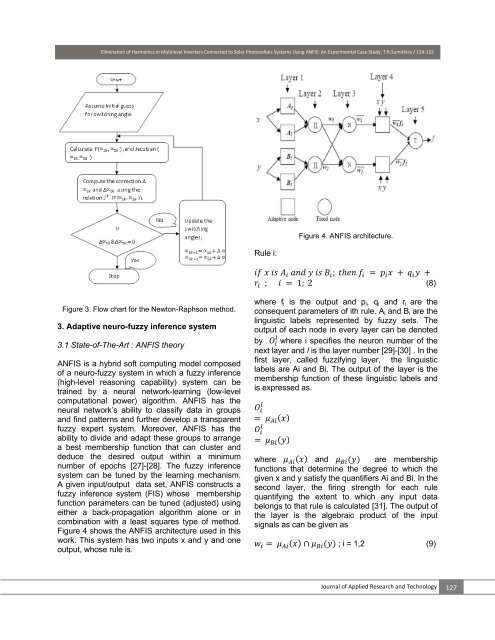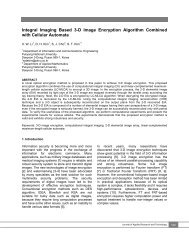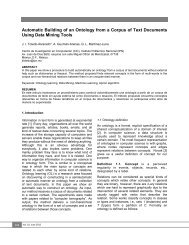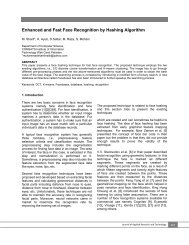Elimination of Harmonics in Multilevel Inverters Connected to ... - JART
Elimination of Harmonics in Multilevel Inverters Connected to ... - JART
Elimination of Harmonics in Multilevel Inverters Connected to ... - JART
You also want an ePaper? Increase the reach of your titles
YUMPU automatically turns print PDFs into web optimized ePapers that Google loves.
<strong>Elim<strong>in</strong>ation</strong> <strong>of</strong> <strong>Harmonics</strong> <strong>in</strong> <strong>Multilevel</strong> <strong>Inverters</strong> <strong>Connected</strong> <strong>to</strong> Solar Pho<strong>to</strong>voltaic Systems Us<strong>in</strong>g ANFIS: An Experimental Case Study, T.R.Sumithira / 124‐132<br />
Rule i:<br />
Figure 4. ANFIS architecture.<br />
; h = + +<br />
; = 1; 2 (8)<br />
Figure 3. Flow chart for the New<strong>to</strong>n-Raphson method.<br />
3. Adaptive neuro-fuzzy <strong>in</strong>ference system<br />
3.1 State-<strong>of</strong>-The-Art : ANFIS theory<br />
ANFIS is a hybrid s<strong>of</strong>t comput<strong>in</strong>g model composed<br />
<strong>of</strong> a neuro-fuzzy system <strong>in</strong> which a fuzzy <strong>in</strong>ference<br />
(high-level reason<strong>in</strong>g capability) system can be<br />
tra<strong>in</strong>ed by a neural network-learn<strong>in</strong>g (low-level<br />
computational power) algorithm. ANFIS has the<br />
neural network’s ability <strong>to</strong> classify data <strong>in</strong> groups<br />
and f<strong>in</strong>d patterns and further develop a transparent<br />
fuzzy expert system. Moreover, ANFIS has the<br />
ability <strong>to</strong> divide and adapt these groups <strong>to</strong> arrange<br />
a best membership function that can cluster and<br />
deduce the desired output with<strong>in</strong> a m<strong>in</strong>imum<br />
number <strong>of</strong> epochs [27]-[28]. The fuzzy <strong>in</strong>ference<br />
system can be tuned by the learn<strong>in</strong>g mechanism.<br />
A given <strong>in</strong>put/output data set, ANFIS constructs a<br />
fuzzy <strong>in</strong>ference system (FIS) whose membership<br />
function parameters can be tuned (adjusted) us<strong>in</strong>g<br />
either a back-propagation algorithm alone or <strong>in</strong><br />
comb<strong>in</strong>ation with a least squares type <strong>of</strong> method.<br />
Figure 4 shows the ANFIS architecture used <strong>in</strong> this<br />
work. This system has two <strong>in</strong>puts x and y and one<br />
output, whose rule is.<br />
where f i is the output and p i , q i and r i are the<br />
consequent parameters <strong>of</strong> ith rule. A i and B i are the<br />
l<strong>in</strong>guistic labels represented by fuzzy sets. The<br />
output <strong>of</strong> each node <strong>in</strong> every layer can be denoted<br />
by where i specifies the neuron number <strong>of</strong> the<br />
next layer and l is the layer number [29]-[30] . In the<br />
first layer, called fuzzify<strong>in</strong>g layer, the l<strong>in</strong>guistic<br />
labels are Ai and Bi. The output <strong>of</strong> the layer is the<br />
membership function <strong>of</strong> these l<strong>in</strong>guistic labels and<br />
is expressed as.<br />
<br />
<br />
= ()<br />
<br />
<br />
= ()<br />
where () and () are membership<br />
functions that determ<strong>in</strong>e the degree <strong>to</strong> which the<br />
given x and y satisfy the quantifiers Ai and Bi. In the<br />
second layer, the fir<strong>in</strong>g strength for each rule<br />
quantify<strong>in</strong>g the extent <strong>to</strong> which any <strong>in</strong>put data<br />
belongs <strong>to</strong> that rule is calculated [31]. The output <strong>of</strong><br />
the layer is the algebraic product <strong>of</strong> the <strong>in</strong>put<br />
signals as can be given as<br />
= () ∩ () ; i = 1,2 (9)<br />
Journal <strong>of</strong> Applied Research and Technology 127







